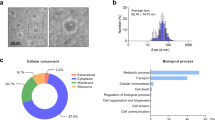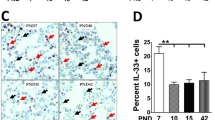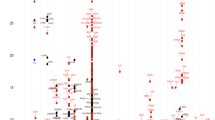Abstract
The recently identified cell surface immunoreceptor MILR1 (mast cell immunoglobulin-like receptor 1; synonyms, Allergin-1) has been shown to suppress immunoglobulin E (IgE)-mediated, mast cell-dependent responses in both mice and humans. We performed a mutation search of MILR1 together with a genetic association study to determine whether polymorphisms in MILR1 are associated with atopy in human. Mutation screening of MILR1 was performed using DNA from 146 unrelated Japanese. Genotyping of the identified polymorphisms was done with 1505 individuals from the general Japanese adult population. Atopy, as defined by positive responses for specific IgEs against at least one of the 26 common allergens, was evaluated using MAST-26. Five polymorphisms (rs6504230, c.−170_−166delAGGAA, rs8071835, rs143526766 and rs12936887) and two rare missense variants (Val273Ala and Leu311Val) were identified by mutation screening. The C allele of rs6504230 had protective effects against atopy (P=0.002). A luciferase reporter assay using the promoter region of MILR1 revealed that the C allele of rs6504230 was associated with increased expression of MILR1, which was in accordance with the results of expression quantitative trait loci analysis using human leukocytes. Our data indicates that the rs6504230 polymorphism affects MILR1 expression levels in humans, leading to a susceptibility to producing specific IgE antibodies against common allergens.
Similar content being viewed by others
Log in or create a free account to read this content
Gain free access to this article, as well as selected content from this journal and more on nature.com
or
References
Asher, M. I., Montefort, S., Bjorksten, B., Lai, C. K., Strachan, D. P., Weiland, S. K. et al. Worldwide time trends in the prevalence of symptoms of asthma, allergic rhinoconjunctivitis, and eczema in childhood: ISAAC Phases One and Three repeat multicountry cross-sectional surveys. Lancet 368, 733–743 (2006).
Burrows, B., Martinez, F. D., Halonen, M., Barbee, R. A. & Cline, M. G. Association of asthma with serum IgE levels and skin-test reactivity to allergens. New Engl. J. Med. 320, 271–277 (1989).
Clarke, J. R., Jenkins, M. A., Hopper, J. L., Carlin, J. B., Mayne, C., Clayton, D. G. et al. Evidence for genetic associations between asthma, atopy, and bronchial hyperresponsiveness: a study of 8- to 18-yr-old twins. Am. J. Respir. Crit. Care Med. 162, 2188–2193 (2000).
Feijen, M., Gerritsen, J. & Postma, D. S. Genetics of allergic disease. Br. Med. Bull. 56, 894–907 (2000).
Bouzigon, E., Forabosco, P., Koppelman, G. H., Cookson, W. O., Dizier, M. H., Duffy, D. L. et al. Meta-analysis of 20 genome-wide linkage studies evidenced new regions linked to asthma and atopy. Eur. J. Hum. Genet. 18, 700–706 (2010).
Ober, C. & Hoffjan, S. Asthma genetics 2006: the long and winding road to gene discovery. Genes Immun. 7, 95–100 (2006).
Vercelli, D. Discovering susceptibility genes for asthma and allergy. Nat. Rev. Immunol. 8, 169–182 (2008).
Bonnelykke, K., Matheson, M. C., Pers, T. H., Granell, R., Strachan, D. P., Alves, A. C. et al. Meta-analysis of genome-wide association studies identifies ten loci influencing allergic sensitization. Nat. Genet. 45, 902–906 (2013).
Hinds, D. A., McMahon, G., Kiefer, A. K., Do, C. B., Eriksson, N., Evans, D. M. et al. A genome-wide association meta-analysis of self-reported allergy identifies shared and allergy-specific susceptibility loci. Nat. Genet. 45, 907–911 (2013).
Hitomi, K., Tahara-Hanaoka, S., Someya, S., Fujiki, A., Tada, H., Sugiyama, T. et al. An immunoglobulin-like receptor, Allergin-1, inhibits immunoglobulin E-mediated immediate hypersensitivity reactions. Nat. Immunol. 11, 601–607 (2010).
Denham, S., Koppelman, G. H., Blakey, J., Wjst, M., Ferreira, M. A., Hall, I. P. et al. Meta-analysis of genome-wide linkage studies of asthma and related traits. Respir. Res. 9, 38 (2008).
Masuko, H., Sakamoto, T., Kaneko, Y., Iijima, H., Naito, T., Noguchi, E. et al. Lower FEV1 in non-COPD, nonasthmatic subjects: association with smoking, annual decline in FEV1, total IgE levels, and TSLP genotypes. Int. J. Chron. Obstruct. Pulmon. Dis. 6, 181–189 (2011).
Nakagawa, T., Komase, Y., Ikezawa, Z., Aihara, M., Iwasaki, E., Okubo, K. et al. [Evaluation of MAST-26, newly developed system for the detection of IgE antibodies]. Arerugi 49, 335–344 (2000).
Barrett, J. C., Fry, B., Maller, J. & Daly, M. J. Haploview: analysis and visualization of LD and haplotype maps. Bioinformatics 21, 263–265 (2005).
de Bakker, P. I., Yelensky, R., Pe'er, I., Gabriel, S. B., Daly, M. J. & Altshuler, D. Efficiency and power in genetic association studies. Nat. Genet. 37, 1217–1223 (2005).
Stranger, B. E., Montgomery, S. B., Dimas, A. S., Parts, L., Stegle, O., Ingle, C. E. et al. Patterns of cis regulatory variation in diverse human populations. PLoS Genet. 8, e1002639 (2012).
Yang, T. P., Beazley, C., Montgomery, S. B., Dimas, A. S., Gutierrez-Arcelus, M., Stranger, B. E. et al. Genevar: a database and Java application for the analysis and visualization of SNP-gene associations in eQTL studies. Bioinformatics 26, 2474–2476 (2010).
Gonzalez, J. R., Armengol, L., Sole, X., Guino, E., Mercader, J. M., Estivill, X. et al. SNPassoc: an R package to perform whole genome association studies. Bioinformatics 23, 644–645 (2007).
Purcell, S., Cherny, S. S. & Sham, P. C. Genetic Power Calculator: design of linkage and association genetic mapping studies of complex traits. Bioinformatics 19, 149–150 (2003).
Nagai, K., Tahara-Hanaoka, S., Morishima, Y., Tokunaga, T., Imoto, Y., Noguchi, E. et al. Expression and function of allergin-1 on human primary mast cells. PLoS ONE 8, e76160 (2013).
Wood, A. R., Hernandez, D. G., Nalls, M. A., Yaghootkar, H., Gibbs, J. R., Harries, L. W. et al. Allelic heterogeneity and more detailed analyses of known loci explain additional phenotypic variation and reveal complex patterns of association. Hum. Mol. Genet. 20, 4082–4092 (2011).
Acknowledgements
We are grateful to the participants in the study. This work is supported by the fund from the Japan Science and Technology Agency (JST), Core Research for Evolutional Science and Technology (CREST), Tokyo, Japan.
Author information
Authors and Affiliations
Corresponding author
Additional information
Supplementary Information accompanies the paper on Journal of Human Genetics website
Supplementary information
Rights and permissions
About this article
Cite this article
Nanatsue, K., Ninomiya, T., Tsuchiya, M. et al. Influence of MILR1 promoter polymorphism on expression levels and the phenotype of atopy. J Hum Genet 59, 480–483 (2014). https://doi.org/10.1038/jhg.2014.57
Received:
Revised:
Accepted:
Published:
Issue date:
DOI: https://doi.org/10.1038/jhg.2014.57



